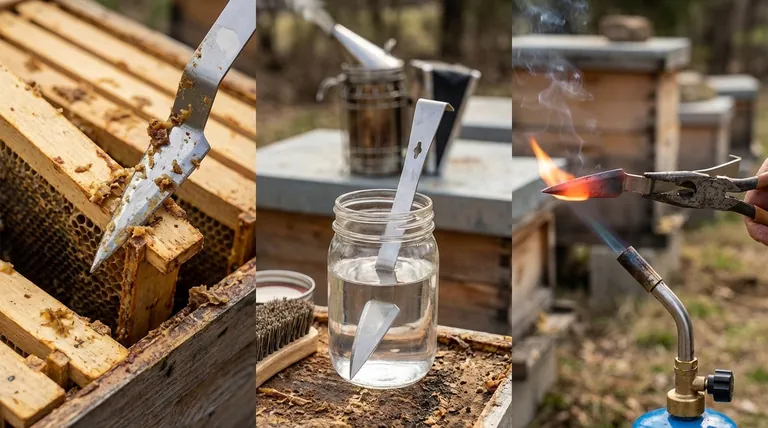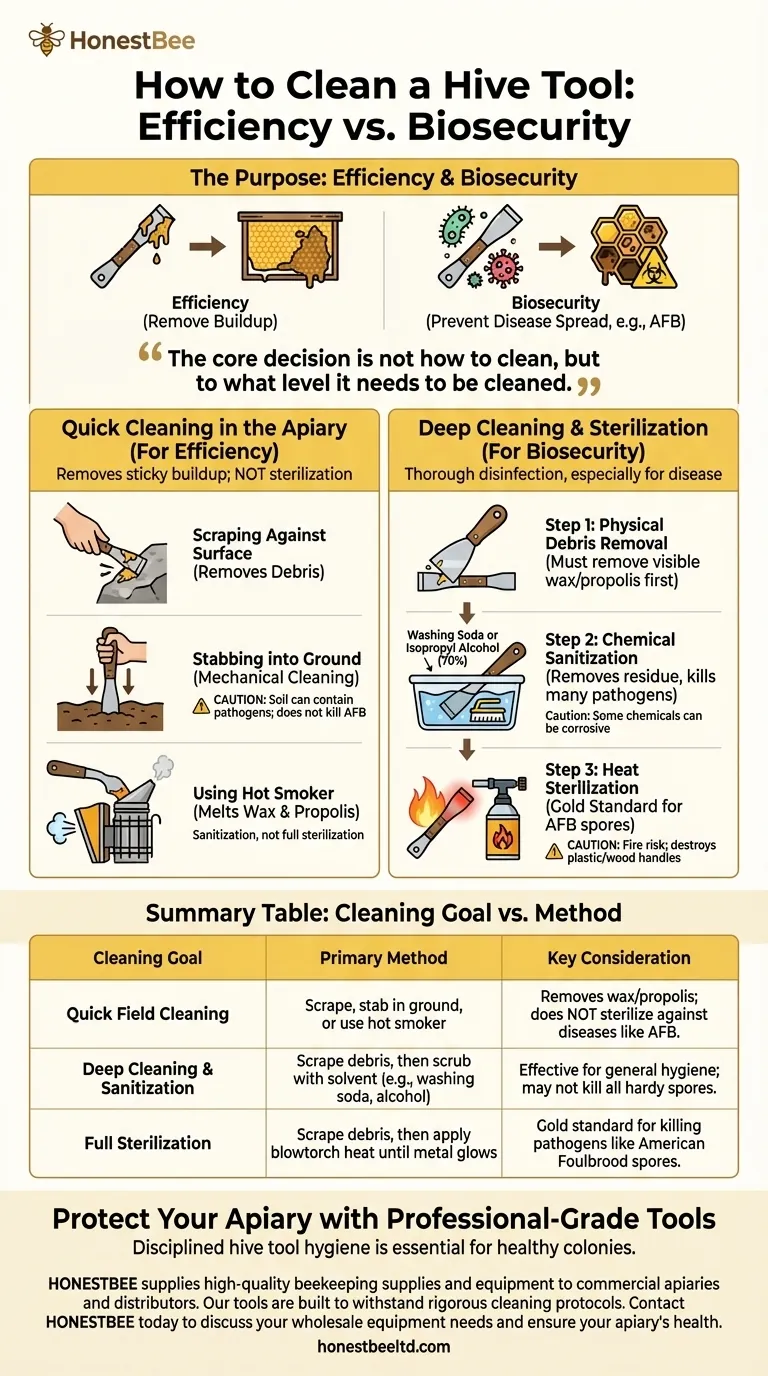To clean a hive tool, you can use several methods depending on your goal. For a quick clean in the field, scraping the tool and then stabbing it into the ground or placing it in a hot smoker will remove wax and propolis. For deep cleaning and sterilization, you must first scrape off all debris, then scrub the tool with a solvent like washing soda or isopropyl alcohol, or use a blowtorch to sterilize it with high heat.
The core decision is not how to clean your hive tool, but to what level it needs to be cleaned. The choice between a quick scrape and a full heat sterilization depends entirely on your apiary's health and your goal of preventing disease transmission.

The Purpose of Cleaning: Efficiency vs. Biosecurity
A hive tool gets coated in sticky propolis, beeswax, and honey during normal use. This buildup can make the tool difficult to handle and can gum up hive components.
More importantly, a dirty hive tool is a primary vector for spreading devastating bee diseases, like American Foulbrood (AFB), from one colony to another.
Quick Cleaning in the Apiary
These methods are designed for efficiency during hive inspections to remove sticky buildup between hives.
Scraping Against a Hard Surface
The simplest first step is always to use the edge of your tool to scrape itself clean, or to scrape it against a rock or the edge of a hive box. This removes the bulk of the debris.
Stabbing into the Ground
Stabbing the tool repeatedly into firm soil can effectively rub off propolis and wax. It's a fast, convenient method when moving between healthy hives.
Using a Hot Smoker
Placing the end of the tool into the hot fire pot of your smoker will quickly melt off wax and propolis. Pumping the bellows will increase the heat and speed up the process.
Deep Cleaning and Sterilization
These methods are for thoroughly cleaning and disinfecting your tools, typically after you have finished work in the apiary or if you suspect disease.
Step 1: Physical Debris Removal
Before any sanitizing agent can work, you must physically remove all visible wax and propolis. Propolis can shield pathogens from chemicals or heat.
Use the sharp edge of the tool or a putty knife to scrape the surfaces completely clean.
Step 2: Chemical Sanitization
After scraping, a chemical wash will remove residue and kill many bacteria and viruses.
Soak the tool in a solution of washing soda (sodium carbonate) or a diluted bleach solution (1 part bleach to 5 parts water). A scrub with a stainless-steel scouring pad can help.
Alternatively, a soak in 70% isopropyl alcohol is an effective disinfectant for many pathogens.
Step 3: Heat Sterilization
Heat is the most reliable way to kill hardy spores, particularly those of American Foulbrood.
Using a propane blowtorch to heat the metal surfaces of the tool until they are glowing hot (or for at least 30 seconds) is the gold standard for sterilization. This will destroy virtually all pathogens.
Understanding the Trade-offs
No single method is perfect for every situation. Understanding their limitations is key to responsible beekeeping.
Field Methods: Fast but Incomplete
Stabbing a tool in the ground is not a sterilization technique. Soil itself can contain pathogens, and this method does not kill AFB spores. It is purely for mechanical cleaning.
A quick burn in a smoker is better, but it may not get the tool hot enough for long enough to guarantee sterilization against hardy spores. It is best considered a sanitization step.
Chemical Cleaning: Effective but with Caveats
Chemicals like bleach can be corrosive to metal tools over time if not rinsed thoroughly. They are also less effective if any propolis or wax remains on the tool.
Solvents like alcohol are effective but can be costly and require safe storage and handling.
Heat Sterilization: The Gold Standard with Risks
Flame sterilization with a blowtorch is the most effective method, especially for known disease outbreaks.
However, it poses a significant fire risk and must be done on a non-flammable surface away from any combustibles. It will also destroy any tool with plastic or wooden components.
Choosing the Right Cleaning Protocol
Your cleaning regimen should adapt to the task at hand.
- If your primary focus is a routine inspection in a healthy apiary: A quick scrape and a moment in the hot smoker between hives is a practical and effective habit.
- If your primary focus is managing a known or suspected disease outbreak: You must use full heat sterilization with a blowtorch after every single hive to prevent cross-contamination.
- If your primary focus is end-of-season equipment maintenance: A thorough scraping followed by a soak in washing soda or isopropyl alcohol will prepare your tools for storage and the season ahead.
Ultimately, disciplined tool hygiene is a non-negotiable cornerstone of proactive and responsible beekeeping.
Summary Table:
| Cleaning Goal | Primary Method | Key Consideration |
|---|---|---|
| Quick Field Cleaning | Scrape, stab in ground, or use hot smoker | Removes wax/propolis; does NOT sterilize against diseases like AFB. |
| Deep Cleaning & Sanitization | Scrape debris, then scrub with solvent (e.g., washing soda, alcohol) | Effective for general hygiene; may not kill all hardy spores. |
| Full Sterilization | Scrape debris, then apply blowtorch heat until metal glows | Gold standard for killing pathogens like American Foulbrood spores. |
Protect Your Apiary with Professional-Grade Tools
Disciplined hive tool hygiene is essential for healthy colonies. Equip your operation with durable, easy-to-clean tools designed for commercial beekeeping demands.
HONESTBEE supplies high-quality beekeeping supplies and equipment to commercial apiaries and distributors through our wholesale-focused operations. Our tools are built to withstand rigorous cleaning protocols, helping you maintain the highest biosecurity standards.
Contact HONESTBEE today to discuss your wholesale equipment needs and ensure your apiary's health.
Visual Guide

Related Products
- HONESTBEE Professional Long Handled Hive Tool with Precision Cutting Blade
- HONESTBEE Premium Italian Style Hive Tool with Hardwood Handle
- Professional Multi-Function Stainless Steel Hive Tool
- HONESTBEE Advanced Ergonomic Stainless Steel Hive Tool for Beekeeping
- Professional Dual-End Stainless Steel Hive Tool for Beekeeping
People Also Ask
- What is the hive tool used for? The Essential Multi-Tool for Every Beekeeper
- How should beekeepers handle bees when using a hive tool? Master Calm, Deliberate Techniques
- Why do hive tools have a hole? Unlock the Secret to Efficient Beekeeping
- What are some common uses of a hive tool? Essential Multi-Purpose Tool for Every Beekeeper
- What are the basic tools for beekeeping? Essential Starter Kit for Safe & Successful Hive Management



















